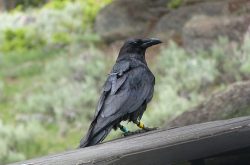
Summers for UW Environment students are often spent working as interns, taking summer classes or accompanying faculty conducting field research. But the spring and summer of 2020 were anything but typical as COVID-19 forced faculty and students to figure out alternative plans or rethink research. With the belief that many students learn best when doing, known as immersive learning, many researchers have had to pivot to still provide students with the resources and opportunities normally available.
School of Environmental and Forest Sciences’ Georgia Coleman had planned on traveling with Professor John Marzluff to Yellowstone National Park back in March in a class titled Wildlife Conservation in Northwest Ecosystems (ESRM 459). That trip was scrapped as both the park and in-person classes were shut down, but luckily Coleman was eventually able to make the journey east in June.
So how did she manage field work for this class when COVID-19 guidelines were still in place? ESRM 459 is a field course, meaning that class time is spent working on a project in preparation for the trip to the field station after the end of the quarter. This June, instead of the entire class taking the trip, just Coleman and one other student met with Marzluff and his wife in Yellowstone to conduct field work. They drove separately and slept in separate cabins, and signed daily attestations that they had no signs of illness two weeks prior and every day on the trip. Daily temperature checks were routine, and masks and social distancing were used. As visitors started to increase at the park after reopening, the group stayed off-trail while out in the field.
Other aspects of field work remained the same. Marzluff led the group in studying common ravens (Corvus corax) in Yellowstone, finding raven nests to count the young, and observing ravens foraging and settling into their night roosts.

Part of their research included monitoring about 60 ravens in the park, all wearing solar-powered GPS backpacks with an antenna that submits the birds’ locations every 30 minutes throughout the day. Using this data, Marzluff and his students are able to piece together the movement of ravens from sunrise to sunset. Using these data, Coleman was able to make estimates about where ravens forage, and where they roost at night.
Marzluff spent much of his career investigating raven roosting and foraging, but the technology needed to answer these questions and closely follow ravens didn’t exist. Following one raven on foot from one foraging site to the next, or from a foraging site to a roost posed not only logistical challenges, but was also extremely time consuming and relied on luck to find these sites. Now, with these GPS backpacks, Marzluff and his students are able to get much more accurate data with significantly less effort.
For her project, Coleman specifically investigated whether the ravens return to the same roosts every night and what the birds are roosting on, referred to as a substrate. Yellowstone is an interesting place to conduct this research because the park contains a variety of substrates – everything from trees to roofs to powerlines to exposed mountains higher than 10,000 feet.
“I think roosting in particular is fascinating because of the role it plays in the birds’ lives,” said Coleman. “Ravens are social animals, so roost sites are not only a safe place to rest, they also provide the birds with the chance to form social bonds and allow them to gain information about foraging opportunities. Knowing the benefits of roosting makes me curious to know why they roost where they do.”
Looking at the data points that bookend the day, Coleman determines where roosts are located based on the earliest point (usually around sunrise) and marks that area as a roost site. These data points tell a varying story – sometimes the latest and earliest points are near one another leading Coleman to be fairly confident in roost sites, and other times the points are thousands of meters apart, leading to less confidence.

Besides studying ravens in the field, the group also saw and learned about some of Yellowstone’s rich wildlife history. While at the park they stayed at the historic Lamar Buffalo Ranch, where bison, now plentiful in the park, were raised in the early 1900s after hunting nearly decimated the population. The successful reintroduction of bison to the park is a wildlife conservation success story that many are not even aware of.

Another historic location visited was the Rose Creek pen, where wolves captured from Canada were acclimated before their reintroduction back into the park as part of a wolf restoration plan. Wolves were virtually eliminated from most of the lower 48 states by the mid-1900s, so the visit to the pen was timely as this year marks the 25th anniversary of the wolf reintroduction. The massive fence of the pen is starting to fall over, but the wooden boxes the wolves were brought in still remain, as do the bones of their meals.
“Visiting the pen, and then getting to watch adult wolves hunt and wolf pups play, was a surreal, beautiful experience,” said Coleman. “Learning about these conservation success stories in my classes at UW is interesting but observing healthy bison and wolf populations in person is an experience I’ll never forget.”
In this time of great uncertainty, even the best laid plans need adjusting in efforts to adhere by COVID-19 guidelines and keep everyone as safe and healthy as possible. A lot of changes had to be made, with maximum flexibility and quick decision making, but field work is still possible and can be just as impactful as always.

